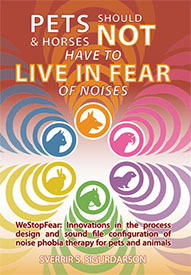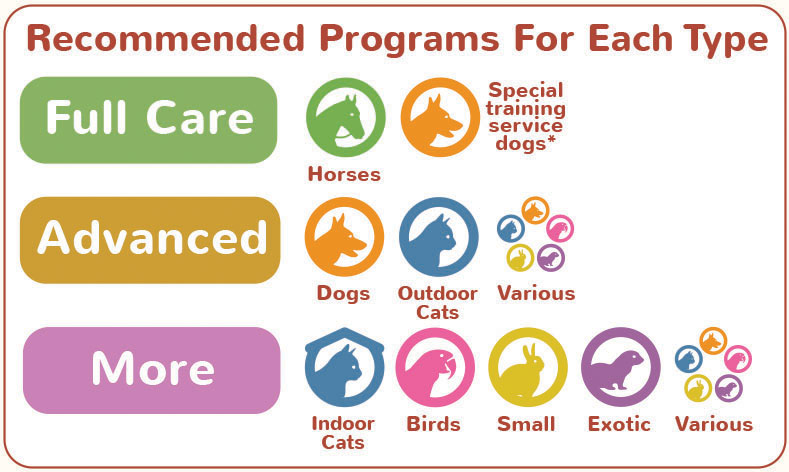 The text on this page is from the book "Pets and Horses Should Not Have To Live In Fear Of Noises" The book is available on Amazon.com as Print version or Kindle version.
The text on this page is from the book "Pets and Horses Should Not Have To Live In Fear Of Noises" The book is available on Amazon.com as Print version or Kindle version. (From page 111 of the book)
The WeStopFear™ solution basically offers the Simple Secure Steps that contain four fundamental innovations in the process design and configuration of the audio files for noise phobia threapy. These four innovations are:
- Volume Anchor™
- Ascending Loudness™
- Timed Access™
- Natural Intervals™
In short, these four innovations are, and their purpose in the overall process:

Simple Secure Steps™
The innovation of Simple Secure Steps™ entails, that the process is broken down into several steps. In the WeStopFear system it is five steps, but it is of course possible to have more steps than that, or even fewer steps although that is probably not a good idea.
Each step has its own set of sound files. The sound files in all the steps are the same, but the volume of the sounds is pre-set to correct levels for the step that the handler and the animal(s) are at.

1. Volume Anchor™
Volume Anchor™ works directly with the Simple Secure Steps. The volume anchor is a sound file which the handler plays in the beginning of the session. With this sound file, the handler sets the volume level of the playback device, the loudspeakers. This sound file is the same in all the steps, and its pre-set volume level is always the same.
In the WeStopFear system, the author hired a piano player, Music4star, in the US to play the Prelude in C Major, by Johan Sebastian Bach. This is a beautiful piece of music that is comfortable to listen to and is perfectly fitting to be used as the Volume Anchor™.

2. Ascending loudness™
There isn’t one set of sound files. There are five sets, or one set for each of the Simple Secure Steps. The loudness of the therapy sounds is pre-set in each of the sets, with Ascending Loudness™. That means that the therapy sounds in the first step is at a very low pre-set volume, and then the volume increases in each step, with the sound files set for step 5 being at full loudness.
The handler plays the piano tune to anchor the volume, and the volume setting on the playback device that is used in a certain location will be the same, on the playback device, throughout all the steps. It’s the Ascending Loudness™ of the sounds in the sound file set for each step that means that the playback volume of the sounds increases as the handler progresses through the steps, but the handler doesn’t have to find the playback volume and gradually increase it via manual conduct, the volume setting on the device is always the same.

3. Timed Access™
In both the classical single-file solution, and the music mix solution (on CDs at least), one of the risks are that the handler will accidentally play the sounds too loudly, too early, that can lead to overexposure for the animal. This overexposure of the sound volume can lead to a shock and setback and can in itself cause fear or even phobia that can be difficult and time consuming to heal.
A feature of the new method is timed access. The sound files are pre-set at the correct volume for each step, meaning that the first set of sounds is set very low, and the second set is only gradually louder than the first.
In the beginning, in the WeStopFear solution, the handler will lonely be given access to the first set. The sounds in that set are at a volume that is so low, that the danger of playing the sounds too loudly is really close to zero. Especially, if the handler has set the volume in the beginning using the piano tune as Volume Anchor, then the danger simply isn’t there.
The handler will only be given access to the subsequent, and louder, sound file sets that are at a higher volume, by going through a process where the handler must verify that the goal has been reached in the previous step. And it is only after a set amount of time, from the moment when the handler starts a step, that the handler is given the chance of verifying the process and go on to the next step.
This Timed Access should ensure, that the danger of overexposure, or of playing sounds too loudly, too early, is reduced to close to none.
How the Simple Secure Steps™ and Volume Anchor™ work together
The Simple Secure Steps™ and Volume Anchor™ work together and make managing the noise phobia therapy process simpler and easier for the handler. They are also designed to deliver the benefit of the noise therapy being safer for the dog, because the risk of playing sounds too loud, too early in the process, has effectively been designed out of the process. It is not possible to make this mistake, given that the dog owner selects the sets of sounds in the correct order, from Step 1 and through to Step 5.
Here is how this innovation works:
In the beginning of step 1, the handler has chosen the location where the sounds will be played and has arranged the playback device. Making sure that the animal doesn’t sense that anything unusual is going on, he or she starts playing the first sound, the volume anchor, which is the soft sounding piano tune by Chopin. During the process, the sounds should appear as by chance, and the animal should not realize that it is in fact the handler who administers the sounds.
The handler sets the volume of the playback device, so that the piano tune is at a comfortable listening level, not very high like a rock concert, and not very low like dinner music. Just somewhere in the middle. If it is possible to write down exactly what the volume level is, in this location, it is very good that the handler does that. The handler will retain this information. Each time that the handler plays the sound set in this location, the volume setting should be at this setting he or she has just determined.
The volume setting is always the same
This is the important point: The volume setting on the playback device, in the chosen location, should always be the same.
The volume setting on the same playback device, if this is a portable playback device, may be different in another location, where the acoustical characteristics of the location are different. For instance, you would generally expect, that the volume needs to be higher in an outside setting, rather than in a small room inside a house.
If the handler has been able to write down what the volume setting is, for instance at some certain level on the scale from 1 to 10 by the volume knob, then the handler will never need to play the first tune, the piano tune or volume anchor, again, in that location, before playing the therapy sounds. The playback device has hereby been anchored in the right volume setting for this location.
If the handler cannot write down the volume setting, then the handler will need to play the volume anchor piano tune at the beginning of each and every therapy session. In that case, it would be better to play the sound, set the volume, and then let some time, several minutes, pass before starting to play the therapy sounds themselves.
Now that the playback device has been anchored at the correct volume level in the location, the handler can commence playing the therapy sounds.
This is where the different steps, the different sound sets, deliver the right volume of the therapy sounds.

Each step has the correct volume level of the sounds
In the sound set for Step 1, the therapy sounds have a pre-set volume level that is very, very low. This is the beginning level in the process, and very unlikely that the animal will be bothered at all by the sounds. If it is, then there is reason for the handler to be concerned about the state of the animal. The handler needs to proceed very cautiously, in accordance with the instructions.
The sound set for Step 2 is pre-set at a volume level that is a bit higher, but still rather low. The volume anchor, however, is always at the same volume level.
The sound set for Step 3 is at medium volume level.
The sound set for Step 4 is quite high.
And finally (as the reader is probably realizing already), the collection of therapy sounds in Step 5 is very high. When played at the pre-determined volume setting on the playback device for the location in question, the sounds will be loud as if the phenomena emitting the sounds are very near. Again, the Volume Anchor, if the handler needed to play that to set the volume in the beginning of each session, was always at the same volume.
Because of the Volume Anchor, the handler has never needed to really worry about the volume setting on the playback device. The volume setting is always the same. And if the handler could write down and keep information about what the right volume setting was for this location, the handler only needed to play the piano tune, the volume anchor, once, for this particular location and this playback device. The volume of the therapy sounds would then be delivered at the right sound volume every time, through the steps 1, 2, 3, 4 and 5.
This is the big change from the previous, classical method, where the handler had only one set of sound files, and needed to set the volume manually each time, correctly for where the handler and the animal were in the process.
Now one may ask if five steps are enough? Why not seven steps, ten steps? Of course, there is nothing stopping you from doing that. The question is only how large and complex you want the therapy set to be.
The point is that the volume setting of the sound files, with a playback device of a certain size with an amplifier and loudspeakers of a certain size, are not the only things that determine the sound volume that the animal is experiencing. The other thing is the distance between the animal and the loudspeakers. Is the animal at a certain point in time standing one, five, fifteen or twenty-five feet away from the loudspeakers of the playback device? The sound volume is very different.
This means that while setting the volume level of the sounds correctly at each step of the way is much, much simpler, and the danger of playing the sounds too loudly, too early is essentially eliminated, then there is still some variety in how loud the sounds are that the animal hears. Some manual management of the proximity of the animal from the playback device is still needed.
But the other thing, setting the volume level of the playback, is now much simpler, easier, and safer.
This is the reason why this is called the Simple Secure Steps.
The third main innovation is the Natural Intervals™.

4. Natural Intervals™
The third innovation is Natural Intervals™. It is designed to make the experience that the dog gets of hearing the sounds more natural, i.e., the experience is closer to the actual experience, when the sounds are heard in their natural settings.
The idea for the Natural Intervals came when the author was speculating about one certain aspect of the previous classical method, and how those solutions don’t match with how animals experience the sounds in the actual, natural settings.
The previous solutions were most commonly CD discs with various types of sounds, one sound coming right after the other. The CD disc format is formatted as such, (called the Red book formatting), that there is a fixed, 2 second pause between tracks on each CD. This means, that when the CD disc is played, each sound comes right after the other, like a line of freight cars in a freight train. There is hardly any space in between.
This is very much different from how the dog, (or other type of animal), experiences the sounds in real-life. In reality, each type of sound comes randomly (or not randomly based on the situation), in a certain setting. The situation is not so, that the animal hears all these types of sounds that may potentially (but not surely) make an animal frightened, each sound right after the other. Let’s say that is the sounds from thunder and lightning, the sound coming from the breaks of a truck, and the sound of a vacuum cleaner, can potentially make a pet frightened.
The situation is not so, that the pet will hear sounds of thunder, and right after that the sound of a vacuum cleaner, and right after that the sound of the air-breaks of a ten-wheel truck, and that the pet will always experience the sounds like that, over and over again.
However, that is how these sounds might be lined up on a CD disc, and thus when that CD disc was being played during noise phobia therapy, the pet would hear these sounds in that order, repeatedly.
This dilemma got the author to think if something could be done to make the appearance, succession, and experience of these sounds more realistic, more natural. And this led to the Natural Intervals innovation. It is quite simple.
Random playback with variable silences
Let’s say that the therapy sounds are on a CD disc, although this can also be a collection of digital sound files in a digital storage device such as a computer or Mp3 player, or digital files streamed over the Internet.
The Natural Intervals are simply silences of variable length that are added after each sound. The length of the silences is different in the five steps. The length of the silences will be between 20 seconds and 1 minute. This isn’t very much, but still it gives a break between the sounds.
This silence can of course be longer, but that would mean that the total playing time of the whole playlist would be correspondingly very long.
So one tries to strike a balance that makes sense for the modern lifestyles of pet and horse owners. Going through an entire playlist will typically take between one and one-and-a-half hours, and one figures that for most people that is enough.
However, if there is demand for longer silences after the sounds, then it is relatively simple to implement.
The original idea was to let the silences be individual sound tracks, which the playback device would then choose randomly in the same way that the device would choose the therapy sound tracks. But in tests, some playback devices seemed to figure out that the silent soundtracks didn’t contain anything, and thus skipped them completely. That of course is not the idea.
It would be possible to add some ambient noise to the silent tracks, but then that noise would be audible for the sensitive ears of the pets or horses, and would become a part of the general soundscape, which isn’t really the goal.
So the solution was chosen to add silences of various lengths behind the therapy noises, as a fixed part of the soundtracks.
The therapy sounds are then played, not straight away, but instead by hitting the “Random” button, which means that all the sound files are played in random order. (Sometimes the button says “RND” or “Shuffle”, or perhaps something else).
This is how the Natural Intervals, along with using the Random playback setting, means that experiencing the sounds is more natural than in the previous CD format, where all the sounds came one after the other. The therapy sounds appear in random order, and there are also silences between the sounds, and the length of these silences are also very varied.
This is much closer to how the animal will experience sounds in the actual natural world. Of course, in reality, there may be days, weeks, and even months, between when a pet hears two different types of sounds. But still, this is at least closer to the actual experiences, than previously when the sound files were played one after the other, in succession.
As you can see, the Natural Intervals and playing the soundtracks using the random (RND) or Shuffle setting will lead to a very varied experience of the therapy sounds. This is much closer to the real-life experience of these sounds, than how it has previously been where the therapy sounds are all played directly one after the other, with no silence between (except for the fixed 2 seconds that are inherent on audio CDs).
A simple implementation and more bearable
The Natural Intervals is not some overly complicated solution, needing special software coding or some special device made and bought specially for this use. These are simply (mostly) silent sound files or soundtracks, sprinkled among the actual therapy sound files or soundtracks. And the Random function is already available on many playback devices. You simply have to hit the button, and the CD, or playlist, will then do the job automatically!
The silence that comes between the therapy sounds will also mean, that the therapy process may become easier to tolerate, both for the pet, and for the human members of the household. These therapy sounds are not nice easy-listening sounds. They are often annoying or uncomfortable in some way, and it can become tiring and burdensome to hear those, especially in the latter parts of the therapy process when the sounds are played at louder and louder volumes.
Getting this relief of a silence in between, of random lengths, will make the process more bearable. That will mean, that it will be less possible, that the human part of the household gets enough, and abandons the therapy before the final success is reached. And as we know, a therapy not finished helps no one.
These are the three innovations that came out of this initiative, to analyze and reinvent the therapy process itself, the steps that the dog owner needs to take to implement the noise phobia therapy.
As said before, this new process architecture as I choose to call it, was developed using the methodology of Process analysis, process re-design and re-engineering.
The basic functioning of the old and new therapy methods is the same
It should be noted that the therapy process method with these three innovations is still the ordinary desensitization and habituation. What the dogs, cats, horses, and other types of pets will experience is unchanged, from the classical noise phobia therapy methods that are available. Sounds are played with the volume being very low in the beginning, and then the volume increases gradually over time until the sounds are played at full volume in the end.
The only real difference is the Natural Intervals mean that there are silent intervals between the therapy sounds, instead of the sounds always coming directly one after the other. This cannot be seen as an unusual occurrence. Rather the previous “classical” method presents the animal with an usual occurrence, where it is an unusual occurrence that the sounds are heard one right after the other, without any silent interval in between. The Natural Intervals should take this unnaturalness out of the experience, and make the process more natural, and more bearable for the parties involved, i.e. the pet and the human parts of the household.
Choose your pet type or horse solution introduction:
Dogs, outdoor cats, indoor cats, horses, pet birds, small mammals, exotic pets, and households with various types of pets.
(Small mammals include rabbits, guinea pigs and hamsters. Exotic pets include chinchilla, degu, fancy mice, fancy rats, fennec fox, ferret, gerbils, hedgehog, sugarglider and pot-bellied pig. Various types of pets are any pet types combination excluding horses.)

Front Pages Links
Sounds and videos
Try the 5 steps therapy sounds players
Sounds in programs (most types)
Sounds in Solutions for Horses
Sounds in Solutions for Outdoor Cats
Explore the 5 step video therapy
The training videos
Further Information
Various information from around the web
Short comparison of WeStopFear and conventional process
What is noise phobia or fear of noises?
Conventional Noise Phobia Therapy
Comparing solutions in the market
A new standard practice for pets and horses?
The book
 The book "Pets and Horses Should Not Have To Live In Fear Of Noises", written by the innovator behind WeStopFear and the Simple Secure Steps, is available on Amazon.com as Print version or Kindle version.
The book "Pets and Horses Should Not Have To Live In Fear Of Noises", written by the innovator behind WeStopFear and the Simple Secure Steps, is available on Amazon.com as Print version or Kindle version.
Chapter: About animal types, fear of sounds, and noise phobia (page 23)
Chapter: Is this new method the best method available? (page 147)
The Story: Why and how WeStopFear was developed (page 160)
About the author and developer (page 189)
Merch and designs
The merch collections and DuFauna designs are designed by the innovator behind WeStopFear and the Simple Secure Steps.
Infographics designed by WeStopFear © Copyright.

